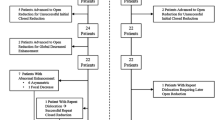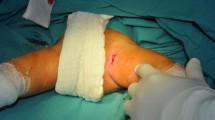Abstract
Background
Magnetic resonance imaging (MRI) of the hips is being increasingly used to confirm hip reduction after surgery and spica cast placement for developmental dysplasia of the hip (DDH).
Objective
To review a single institutional experience with post-spica MRI in children undergoing closed or open hip reduction and describe the utility of MRI in directing the need for re-intervention.
Materials and methods
Seventy-four patients (52 female, 22 male) who underwent post-spica hip MRI over a 6-year period were retrospectively reviewed. One hundred and seven hips were included. Data reviewed included age at intervention, gender, type of intervention performed, MRI findings, the need for re-intervention and the interval between interventions. Gender was compared between the closed and open reduction groups via the Fisher exact test. Age at the first procedure was compared via the Wilcoxon rank test. Rates of re-intervention after closed and open reduction were calculated and the reasons for re-intervention were reviewed.
Results
The mean age at the time of the first intervention was 16.4 months (range: 4 to 63 months). Mean age for the closed reduction group was 10.5 months (range: 4–24 months) and for the open reduction group was 23.7 months (range: 5–63 months), which was significant (P-value <0.0001). Of the 52 hips that underwent closed reduction, 16 (31%) needed re-intervention. Of the 55 hips that underwent open reduction, MRI was useful in deciding re-intervention in only 1 (2%). This patient had prior multiple failed closed and open reductions at an outside institute.
Conclusion
Post intervention hip spica MRI is useful in determining the need for re-intervention after closed hip reduction, but its role after open reduction is questionable.


Similar content being viewed by others
References
Nemeth BA, Narotam V (2012) Developmental dysplasia of the hip. Pediatr Rev 33:553–561
Johnson ND, Wood BP, Jackman KV (1998) Complex infantile and congenital hip dislocation: assessment with MR imaging. Radiology 168:151–156
Bos C, Bloem J (1989) Treatment of dislocation of the hip, detected in early childhood, based on magnetic resonance imaging. J Bone Joint Surg Am 71-A:1523–1529
Jaramillo D, Villegas-Medina OL, Doty DK et al (1996) Gadolinium-enhanced MR imaging demonstrates abduction-caused hip ischemia and its reversal in piglets. AJR Am J Roentgenol 166:879–887
Jaremko JL, Wang CC, Dulai S (2014) Reliability of indices measured on infant hip MRI at time of spica cast application for dysplasia. Hip Int 24:405–416
Bulut M, Gurger M, Belhan O et al (2013) Management of developmental dysplasia of the hip in less than 24 months old children. Indian J Orthop 47:578–584
Desai AA, Martus JE, Schoenecker J, Kan JH (2011) Spica MRI after closed reduction for developmental dysplasia of the hip. Pediatr Radiol 41:525–529
Rosenbaum DG, Servaes S, Bogner EA et al (2016) MR imaging in postreduction assessment of developmental dysplasia of the hip: goals and obstacles. Radiographics 36:840–854
Duffy CM, Taylor FN, Coleman L et al (2002) Magnetic resonance imaging evaluation of surgical management in developmental dysplasia of the hip in childhood. J Pediatr Orthop 22:92–100
Jaramillo D, Villegas-Medina O, Laor T et al (1998) Gadolinium enhanced MR imaging of pediatric patients after reduction of dysplastic hips: assessment of femoral head position, factors impeding reduction, and femoral head ischemia. AJR Am J Roentgenol 170:1633–1637
Tiderius C, Jaramillo D, Connolly S et al (2009) Post-closed reduction perfusion magnetic resonance imaging as a predictor of avascular necrosis in developmental hip dysplasia: a preliminary report. J Pediatr Orthop 29:14–20
Laor T, Roy DR, Mehlman CT (2000) Limited magnetic resonance imaging examination after surgical reduction of developmental dysplasia of the hip. J Pediatr Orthop 20:572–574
Author information
Authors and Affiliations
Corresponding author
Ethics declarations
Conflicts of interest
Dr. J. Herman Kan has received royalties from Elsevier and Springer and a stipend from the National Institutes of Health as a grant reviewer.
Rights and permissions
About this article
Cite this article
Jadhav, S.P., More, S.R., Shenava, V. et al. Utility of immediate postoperative hip MRI in developmental hip dysplasia: closed vs. open reduction. Pediatr Radiol 48, 1096–1100 (2018). https://doi.org/10.1007/s00247-018-4143-7
Received:
Revised:
Accepted:
Published:
Issue Date:
DOI: https://doi.org/10.1007/s00247-018-4143-7




